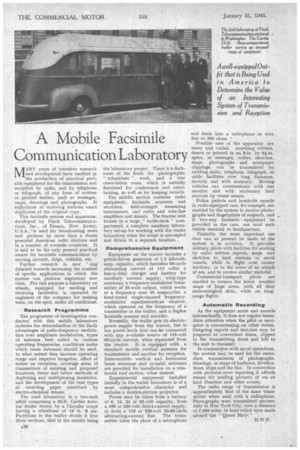A Mobile Facsimile Communication Laboratory
Page 22

If you've noticed an error in this article please click here to report it so we can fix it.
MANY years of intensive research and development have resulted in the production of practical portable equipment for the transmission and reception by radio, and by telephone or telegraph, of any form of written or printed matter, such as messages, maps, drawings and photographs. It • regroduces at receiving stations exact duplicates of the original. copy.
This facsimile system and apparatus, developed' by Finch Telecommunications, Inc., of Passaic, New jersey, U.S.A.,' is used for -broadcasting news and pictures by more than a dozen powerful American radio stations and in a number of overseas countries. It is said to be the only present practical means for facsimile communication by moving aircraft, ships, vehicles, etc.
Further research is now'sing directed towards increasing the number of specific applications in which the system can perform important new roles. For this purpose a laboratoty on wheels, equipped for sending and receiving facsimiles, is operated by engineers of the company for making tests, on the spot, under all conditions.
Research Programme
The programme of investigation conducted with this mobile laboratory includes the determinationof the likely advantages of radio-frequency modulation over amplitude modulation, types of antenna best suited to -various operating frequencies, conditions underwhich beam antennas should be used, to what extent they increase operating range and improve reception, effect of noises on reception, coverage areas of .transmitters at existing and proposed locations, faster and better methods of duplexing and multiplexing facsimiles,
• and the development of the best types of receiving paper sensitized _ by electro-chemical means.
The road laboratory is a two-unit affair comprising a 22-ft. Curtiss Aerocar -trailer drawn by a Chrysler coupe having a wheelbase of 10 ft. 8 ins. Partitions in the trailer divide it into three sections, that in the middle being
the laboratory proper. There is a darkroom at the front for photographic " telepicture " work, and a rear observation room, which is suitably, furnished for conferences and entertaining, as Well as for keeping records.
The middle section contains radio equipment, facsimile scanners and recorders, field-strength measuring instruments, and radio and wire-line amplifiers and mixers. The tractor unit houses in a large_." turtle-deck" compartment, a complete auxiliary laboratory set-up for working with the trailer laboratory when the coupe is uncoupled and driven to a separate location.
Comprehensive Equipment Equipment on the tractor includes a petrol-driven generator of 1.5 kilovoltamp. capacity, which furnishes 60-cycle alternating current at 115 volts; a heavy-duty charger and battery for auxiliary current supply; whip-type antennas; a frequency-modulated transmitter of 25-watt output, which works at a frequency. near 40 megacycles; a fixed-tuned single-channel frequencymodulated superheterodyne receiver, which operates on the frequency of a transmitter in the trailer; and a duplex facsimile scanner and recorder.
Normally, the trailer gets its electricpower .supply from the tractor, but it has power leads that can Ate connected with any available source of 115-volt 60;cycle current, when separated from the tractor. It is equipped with a standard mobile vertical antenna for trarisrnission and another for reception. Demountable vertical 'and horizontal beam antennas and co-axial antennas are provided for installation on a reinforced roof section, when desired.
Experimental equipment installed initially in the trailer laboratory is of a most comprehensive character and includes a motion-picture projector.
Power may be taken from a battery of 6, 12, 24 or 32-volt capacity, from a 100 or 220-volt direct-current supply:or from a 110 or 220=Volt 50:60-cycle_ alternating-current line. The transmitter takes the place of a microphone
arid feeds into a radiophone or wire line at 500 ohms.
Possible uses of the apparatus are many and varied. Anything written, drawn or printed in an 8-in, by space, as messages, orders, sketches, maps, photographs and newspaper clippings, can be transmitted by existing radio, telephone, telegraph, or cable facilities over long distances, secretly and with accuracy'. Moving vehicles can communicate with one another and with stationary land stations by visual means.
Police patrols and homicide squads in radio-equipped cars, for example, are enabled by the system to receive photographs and fingerprints of suspects, and if two-way facsimile equipment be provided in the cars, can send such visible material to headquarters.
Probably the most important use that can at present be made of the system is in aviation. It provides military pilots with facilities for sending by radio written reports, maps and sketches to land stations . or naval vessels, while in night over enemy territory, or to the scene of an attack at sea, and to receive similar material.
Commercial-transport pilots are enabled to receive the latest weather maps of large areas, with all their meteorological -data, while on longrange flights Automatic Recording As the equipment sends and records automatically, it does not require immediate attention when the pilot or navigator is concentrating on other duties. Outgoing reports and sketches may be prepared at convenient tithes, clipped to the transmitting drum and left to the unit to transmit.
In conjunction with naval operations, the system may be used for the immediate transmission of photograplis, drawings, or maps of harbours, fortifications. ships and the like. In connection with pictorial-news reporting it affords means for sending pictures of sea Nor land disasters and other events.
The radio range of transmission is approximately that of the same trans' mitter when used with a radiophone. -Photographs were transmitted successfully to New York City, over a distance of 2,90(1 miles, in tests which were made aboard the " Queen Mary."




















































